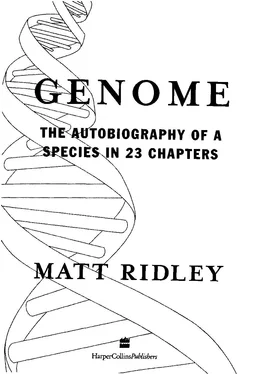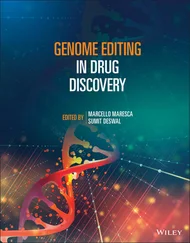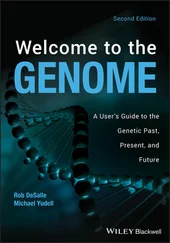Genome - Matt Ridley
Здесь есть возможность читать онлайн «Genome - Matt Ridley» — ознакомительный отрывок электронной книги совершенно бесплатно, а после прочтения отрывка купить полную версию. В некоторых случаях можно слушать аудио, скачать через торрент в формате fb2 и присутствует краткое содержание. Жанр: Старинная литература, на английском языке. Описание произведения, (предисловие) а так же отзывы посетителей доступны на портале библиотеки ЛибКат.
- Название:Matt Ridley
- Автор:
- Жанр:
- Год:неизвестен
- ISBN:нет данных
- Рейтинг книги:5 / 5. Голосов: 1
-
Избранное:Добавить в избранное
- Отзывы:
-
Ваша оценка:
- 100
- 1
- 2
- 3
- 4
- 5
Matt Ridley: краткое содержание, описание и аннотация
Предлагаем к чтению аннотацию, описание, краткое содержание или предисловие (зависит от того, что написал сам автор книги «Matt Ridley»). Если вы не нашли необходимую информацию о книге — напишите в комментариях, мы постараемся отыскать её.
Matt Ridley — читать онлайн ознакомительный отрывок
Ниже представлен текст книги, разбитый по страницам. Система сохранения места последней прочитанной страницы, позволяет с удобством читать онлайн бесплатно книгу «Matt Ridley», без необходимости каждый раз заново искать на чём Вы остановились. Поставьте закладку, и сможете в любой момент перейти на страницу, на которой закончили чтение.
Интервал:
Закладка:
It is comparatively easy to make mouse chimeras in the laboratory by gently fusing the cells from two early embryos. But what the ingenious Cambridge team did in this case was to fuse a normal mouse embryo with an embryo that was made by 'fertilising' an egg with another egg's nucleus, so that it had purely maternal genes and no contribution from the father. The result was a mouse with an unusually large head. When these scientists made a chimera between a normal embryo and an embryo derived only from the father (i.e., S E X 2 1 5
grown from an egg whose nucleus had been replaced by two sperm nuclei), the result was the opposite: a mouse with a big body and a small head. By equipping the maternal cells with the biochemical equivalent of special radio transmitters to send out signals of their presence, they were able to make the remarkable discovery that most of the striatum, cortex and hippocampus of the mouse brain are consistently made by these maternal cells, but that such cells are excluded from the hypothalamus. The cortex is the place where sensory information is processed and behaviour is produced.
Paternal cells, by contrast, are comparatively scarce in the brain, but much commoner in the muscles. Where they do appear in the brain, however, they contribute to the development of the hypothalamus, amygdala and preoptic area. These areas comprise part of the 'limbic system' and are responsible for the control of emotions. In the opinion of one scientist, Robert Trivers, this difference reflects the fact that the cortex has the job of co-operating with maternal relatives while the hypothalamus is an egotistical organ.14
In other words, if we are to believe that the placenta is an organ that the father's genes do not trust the mother's genes to make, then the cerebral cortex is an organ that the mother's genes do not trust the father's genes to make. If we are like mice, we may be walking around with our mothers' thinking and our fathers' moods (to the extent that thoughts and moods are inherited at all). In 1998 another imprinted gene came to light in mice, which had the remarkable property of determining a female mouse's maternal behaviour. Mice with this Mest gene intact are good, caring mothers to their pups. Female mice who lack a working copy of the gene are also normal except that they make terrible mothers. They fail to build decent nests, they fail to haul their pups back to the nest when they wander, they do not keep the pups clean and they generally seem not to care. Their pups usually die. Inexplicably, the gene is paternally inherited. Only the version inherited from the father functions; the mother's version remains silent.15
The Haig theory of conflict over embryonic growth does not easily explain these facts. But the Japanese biologist Yoh Iwasa has 2 l 6 G E N O M E
a theory that does. He argues that because the father's sex chromosome determines the sex of the offspring — if he passes on an X
rather than a Y chromosome, the offspring is female — so paternal X chromosomes are found only in females. Therefore, behaviour that is characteristically required of females should be expressed only from paternal chromosomes. If they were also expressed from maternal X chromosomes, they might appear in males, or they might be overexpressed in females. It therefore makes sense that maternal behaviour should be paternally imprinted.16
The best vindication of this idea comes from an unusual natural experiment studied by David Skuse and his colleagues at the Institute of Child Health in London. Skuse located eighty women and girls aged between six and twenty-five who suffered from Turner's syndrome, a disorder caused by the absence of all or part of the X
chromosome. Men have only one X chromosome, and women keep one of their two X chromosomes switched off in all their cells, so Turner's syndrome should, in principle, make little difference to development. Indeed, Turner's girls are of normal intelligence and appearance. However, they often have trouble with 'social adjustment'. Skuse and his colleagues decided to compare two kinds of Turner's girls: those with the paternal X chromosome missing and those with the maternal X chromosome missing. The twenty-five girls missing the maternal chromosome were significantly better adjusted, with 'superior verbal and higher-order executive function skills, which mediate social interactions' than the fifty-five girls missing the paternal chromosome. Skuse and his colleagues determined this by setting the children standard tests for cognition, and giving the parents questionnaires to assess social adjustment. The questionnaire asked the parents if the child lacked awareness of other people's feelings, did not realise when others were upset or angry, was oblivi-ous to the effect of her behaviour on other members of the family, was very demanding of people's time, was difficult to reason with when upset, unknowingly offended people with her behaviour, did not respond to commands, and other similar questions. The parents had to respond with 0 (for 'not at all true'), 1 for 'quite or sometimes S E X 2 1 7
true' and 2 for 'very or often true'. The total from all twelve questions was then totted up. All the Turner's girls had higher scores than normal girls and boys, but the ones who were lacking the paternal X chromosome had more than twice the score of the ones lacking the maternal X chromosome.
The inference is that there is an imprinted gene somewhere on the X chromosome, which is normally switched on only in the paternal copy and that this gene somehow enhances the development of social adjustment - the ability to understand other's feelings, for example. Skuse and his colleagues provided further evidence of this from children who were missing only part of one X chromosome.17
This study has two massive implications. First, it suggests an explanation for the fact that autism, dyslexia, language impairment and other social problems are much commoner in boys than girls.
A boy receives only one X chromosome, from his mother, so he presumably gets one with the maternal imprint and the gene in question switched off. As of this writing, the gene has not been located, but imprinted genes are known from the X chromosome.
But second, and more generally, we are beginning to glimpse an end to the somewhat ridiculous argument over gender differences that has continued throughout the late twentieth century and has pitted nature against nurture. Those in favour of nurture have tried to deny any role for nature, while those who favour nature have rarely denied a role for nurture. The question is not whether nurture has a role to play, because nobody of any sense has ever gone on record as denying that it does, but whether nature has a role to play at all. When my one-year-old daughter discovered a plastic baby in a toy pram one day while I was writing this chapter, she let out the kinds of delighted squeals that her brother had reserved at the same age for passing tractors. Like many parents, I found it hard to believe that this was purely because of some unconscious social conditioning that we had imposed. Boys and girls have systematically different interests from the very beginning of autonomous behaviour. Boys are more competitive, more interested in machines, weapons and deeds. Girls are more interested in people, clothes and words. To 2 l 8 G E N O M E
put it more boldly, it is no thanks only to upbringing that men like maps and women like novels.
In any case, the perfect, if unconscionably cruel, experiment has been done by the supporters of pure nurture. In the 1960s, in the United States, a botched circumcision left a boy with a badly damaged penis, which the doctor decided to amputate. It was decided to try to turn the boy into a girl by castration, surgery and hormonal treatment. John became Joan; she wore dresses and played with dolls. She grew up into a young woman. In 1973 John Money, a Freudian psychologist, claimed in a burst of publicity that Joan was a well adjusted adolescent, and her case thus put an end to all speculation: gender roles were socially constructed.
Читать дальшеИнтервал:
Закладка:
Похожие книги на «Matt Ridley»
Представляем Вашему вниманию похожие книги на «Matt Ridley» списком для выбора. Мы отобрали схожую по названию и смыслу литературу в надежде предоставить читателям больше вариантов отыскать новые, интересные, ещё непрочитанные произведения.
Обсуждение, отзывы о книге «Matt Ridley» и просто собственные мнения читателей. Оставьте ваши комментарии, напишите, что Вы думаете о произведении, его смысле или главных героях. Укажите что конкретно понравилось, а что нет, и почему Вы так считаете.












